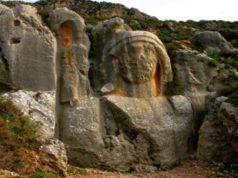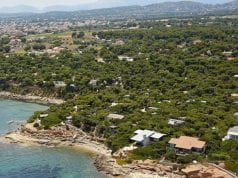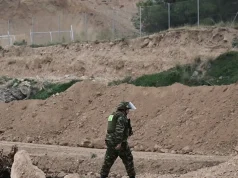The discovery of the 2000 – year- old Antikythera Mechanism, close to the coast of Antikythera, a remote island in the Mediterranean with a population of less than 50 people, continues to inspire worldwide enthusiasm and public awe. The international ΤV networks CNN and BBC, were among those which have shown the greatest interest as were the British newspapers Guardian, The Daily Telegraph and Daily Mail. A really important CNN story, titled “Lost Treasures reclaimed from 2,000 year-old Antikythera shipwreck”, describes the functionalities and complexities of the mechanism, focusing on the research of a group of maritime archaeology experts working at the site since mid September and using the most advanced marine technology available, such as the so called “Iron Man” suit and the “Sirius”.
‘The world’s first computer’ is the title of the filmbroadcasted by the British Network BBC, trying to explain how the ancients of the classical Hellenic Period had the knowledge and creativity to put together such a machine. The machine dates from around the end of the 2nd century B.C. and is the most sophisticated mechanism known from the ancient world.
Nothing as complex is known for the next thousand years. The Antikythera Mechanism is now understood to be dedicated to astronomical phenomena and operates as a complex mechanical “computer” which tracks the cycles of the Solar System. It was a device with at least 30 (some say 70) gears, all precision engineered (the teeth were hand-cut equilateral triangles), designed to predict the movements of the sun and moon, plus six of our closer planetary neighbours. The calendar dial can be moved to adjust for that inconvenient extra quarter day in the solar year.
According to the website www.antikythera-mechanism.gr, a really important aspect that makes this discovery more important is the fact that it is a unique window on history, allowing us to be introduced to the condensed knowledge of ancient Greek astronomy, and through them, the knowledge of the ancient Babylonians. In many ways, the structure is an encyclopedia of astronomy of the time.
It also proves the great mathematical and engineering knowledge of the ancient Greeks. It is estimated that the instrument dated between 200 and 150 BC and is superior to any other clockwork built for more than a millennium later. The level mechanical design of the mechanism is in any case astonishing.
CNN and the other world media have also paid a lot of attention in the recovery of new treasures from the shipwreck by a team that has used the latest technology to accomplish it. As the Guardian and Daily Mail point out, Greek and American archaeologists are returning to the ancient shipwreck of Antikythera wearing the Exosuit, a high- tech, ‘revolutionary’ diving suit, built in Canada by Nuytco Research, which allows them to dive more than double the depths of previous expeditions.
It is made of aluminium, with 18 joints in the arms and legs and it is able to supply oxygen for up to 50 hours, while maintaining communication with the surface via an optical cable. The use of this suit was of major importance, as until recently divers had only been able to operate at a depth of 196ft (60metres). Ed O’Brien from Woods Hole Oceanographic Institution has become the first person to dive the Exosuit in the deep blue water off Antikythera. As well as the Exosuit, the Antikythera expedition will also use robot mapping equipment and new advanced closed-circuit “rebreathers”, which will allow divers much more time underwater.
Another important technology on which CNN focuses on its story, is the ‘SIRIUS’, an autonomous vehicle (AUV) which was created by the Australian Centre for Field Robotics in order to create precise 3D documentation of the expansive debris field. A three dimensional X ray technique is also used in order to generate 3D images, which would help the understanding of the mechanism, according to professors Dr John Steele and Yanis Bitsakis.
Archaeologists believe many other artifacts are yet to be discovered in and around the wreck. ‘We have good signs that there are other objects present,’ stated Angeliki Simosi, head of Greece’s directorate of underwater antiquities, in Daily Mail. The archaeologists also hope to confirm the presence of a second ship, some 820ft (250 metres) away from the original discovery site.
Last but not least, it is worth noting that the Greek team of maritime and archaeology experts is being assisted by Brendan Foley, a marine archaeologist from the Woods Hole Oceanographic Institution at Massachusetts in the US, which was involved in a dive to the wreck of the Titanic. He has helped with outings to identify ancient shipwrecks over the past five years




![Καλλιμάρμαρο: Παραδόθηκε η Ολυμπιακή Φλόγα στο «Παρίσι 2024»-Βίντεο [369158] ΛΑΜΠΑΔΗΔΡΟΜΙΑ ΤΩΝ ΟΛΥΜΠΙΑΚΩΝ ΑΓΩΝΩΝ "ΠΑΡΙΣΙ 2024" / 11η ΗΜΕΡΑ (ΜΑΡΚΟΣ ΧΟΥΖΟΥΡΗΣ / EUROKINISSI)](https://ecozen.gr/wp-content/uploads/2024/04/olympiaki-floga-238x178.jpg)









![Καλλιμάρμαρο: Παραδόθηκε η Ολυμπιακή Φλόγα στο «Παρίσι 2024»-Βίντεο [369158] ΛΑΜΠΑΔΗΔΡΟΜΙΑ ΤΩΝ ΟΛΥΜΠΙΑΚΩΝ ΑΓΩΝΩΝ "ΠΑΡΙΣΙ 2024" / 11η ΗΜΕΡΑ (ΜΑΡΚΟΣ ΧΟΥΖΟΥΡΗΣ / EUROKINISSI)](https://ecozen.gr/wp-content/uploads/2024/04/olympiaki-floga-300x194.jpg)



![Καλλιμάρμαρο: Παραδόθηκε η Ολυμπιακή Φλόγα στο «Παρίσι 2024»-Βίντεο [369158] ΛΑΜΠΑΔΗΔΡΟΜΙΑ ΤΩΝ ΟΛΥΜΠΙΑΚΩΝ ΑΓΩΝΩΝ "ΠΑΡΙΣΙ 2024" / 11η ΗΜΕΡΑ (ΜΑΡΚΟΣ ΧΟΥΖΟΥΡΗΣ / EUROKINISSI)](https://ecozen.gr/wp-content/uploads/2024/04/olympiaki-floga-100x75.jpg)